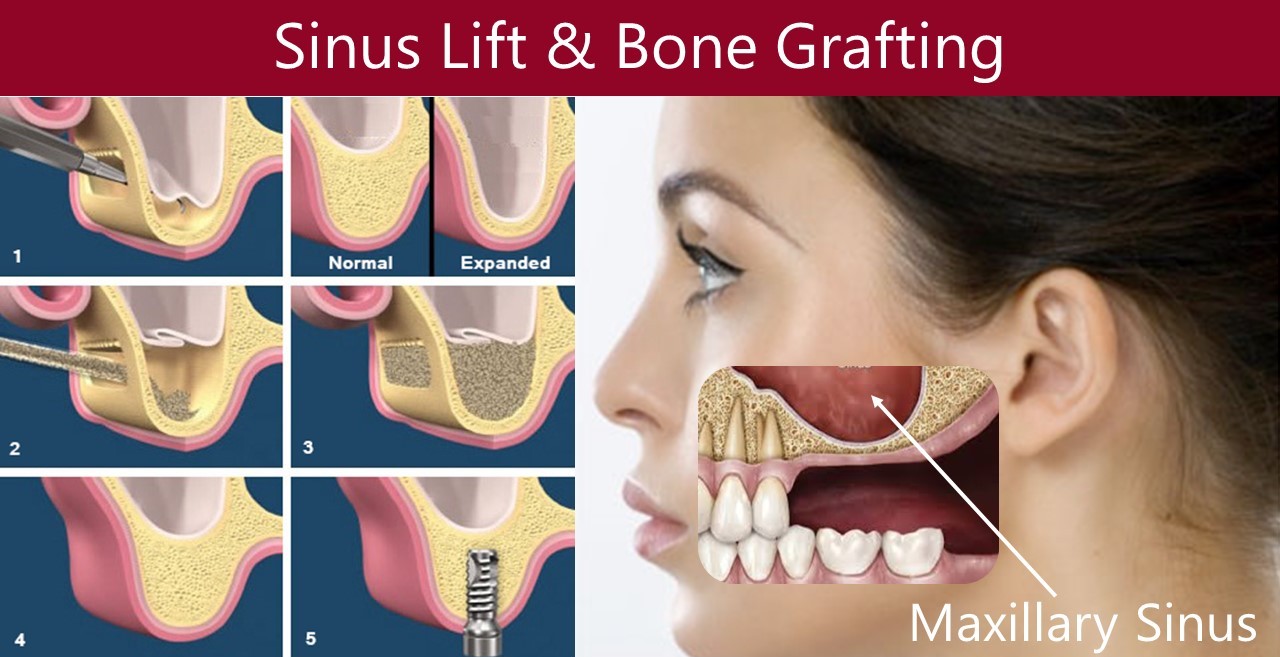


WHAT IS A SINUS LIFT SURGERY?
Before we move any further, let us take a moment to know about the heavily discussed sinus lift surgery. In simple terms, a sinus lift is a surgical procedure that helps to add bone height in the upper jaw in the molar region. Now, let us see why there is a need for adding bone height in the upper jaw molar region. Well, for the placement of a dental implant a certain bone height and width are needed. This is done to make sure that the treatment is a success and there is no complication. A sinus lift is done especially when placement of a dental implant is indicated in the premolar and molar region of the upper jaw.
This procedure may sometimes be also referred to as sinus augmentation. As the term suggests, the sinus is pushed upwards to make space for a dental implant. A bone graft is taken and added between the upper jaw and maxillary sinus. Maxillary sinuses are located on both the sides adjacent to the nose. A sinus is basically a hollow cavity in the bone. The sinus membrane which forms the base of the maxillary sinus is moved upwards, essentially lifted and placed in a more upward position. This is done to make room for the bone.
REASON FOR INADEQUATE BONE HEIGHT IN THE MOLAR REGION OF THE UPPER JAW
Individuals who have lost teeth in the upper jaw because of dental decay, infections, malignancy or trauma often look for a replacement. When such an individual comes to a dental clinic wanting a permanent solution that is fixed teeth on a dental implant, they come to face the fact that they have lost the bone height in the molar and premolar region of the upper jaw which was extremely crucial for placement of a dental implant and its anchoring in the bone.
There are several reasons for the loss on bone volume below the maxillary sinus and some of them are as follows :
- The maxillary sinus has a tendency to expand with age. That means with passing time and aging, patients will soon have a little bone left above the second premolar region, first molar region, and second molar region.
- The second most common reason for bone loss in this area is due to periodontal diseases and infections.
- The third reason which has been discussed in-depth on our website is bone resorption. Once teeth are lost, the bone is that particular area undergoes the process of resorption. This means that the bone in that particular area shrinks and the bone volume is lost.
DISADVANTAGES OF SINUS LIFT SURGERY
Cases where upper jaw dental implant or full mouth implants are indicated, patients are forced to undergo sinus lift surgery. This leads to delays and complications for the patient in acquiring immediate fixed teeth.
There are several reasons why the dental community is shifting to the use of basal implants and tuberopterygoid implants from the sinus lift surgery. Basal implants allow immediate loading that means the patient can get the crown in 3 days after implant placement.
1) Time-consuming: There is a waiting period of 6 months to 1 year after the bone grafting procedure to allow the bone graft to fuse one with the bone, only after this the crown is placed on the dental implant.
2) Cost of sinus lift procedure - sinus lift procedure makes the entire dental implant procedure expensive. The cost of dental implants will vary according to the need.
However, with basal implants and pterygoid implants, the time required is drastically reduced and the cost of dental implant treatment is significantly reduced. That's why at Jani's implant center and smile studio, which is located in Bhavnagar, Ahemdabad we avoid sinus lift and instead suggest going for basal implants.
3) Bone graft failure: the major risk associated with sinus lift is that the sinus membrane may be obliterated or punctured during the procedure. This will need repairing which if not done right will lead to failure of the procedure and fusion of bone graft. This again takes months and invites complications which could have bee avoided by going for the basal implant.
4) Infections - sinus membrane may become infected and compromise dental implant therapy. This means the entire procedure will have to be repeated.
With the advent of tuberopterygoid implants and basal implants, sinus lift surgery and bone grafting is an outdated procedure for the replacement of lost teeth with dental implants.
